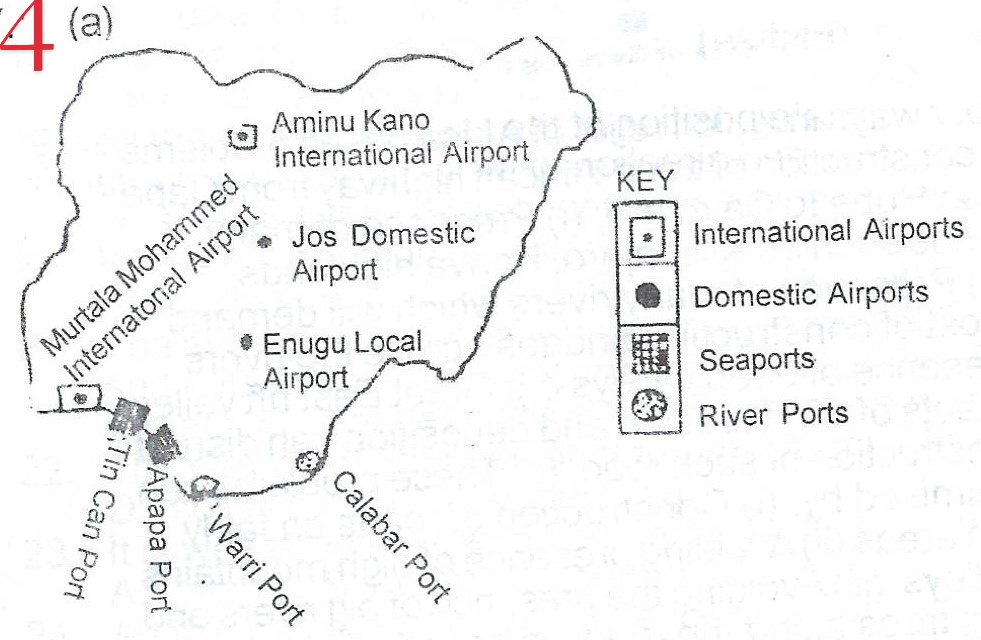Welcome to “Naijaclass Academy” For Waec 2024 Geography Essay & Objective Questions And Answers
Date: Friday, 31st May 2024
Geography (Essay & Objective) 9:30 am – 12:30 pm
——————————
GEOGRAPHY OBJ
1-10: BADBCCADDC
11-20: ACCAACBBCC
21-30: BCABCAABAD
31-40: ABBACAACAC
41-50: CBADABBDBB
=======================================
(1a)
(i) Primary industries involve the extraction and production of raw materials while Secondary industries, on the other hand, are involved in the processing of raw materials into finished products.
(ii) Examples of primary industries include agriculture, fishing, forestry, and mining while Examples of secondary industries include manufacturing, construction, and production of goods such as automobiles, textiles, and electronics.
(iii) Primary industries are usually located in rural areas and are often labor-intensive, relying on natural resources while secondary industries are typically located in urban areas and are more capital-intensive, relying on machinery and technology.
(1b)
(PICK ANY FOUR)
(i) Lower Capital Requirement: Light industries often require less initial investment compared to heavy industries, making them more accessible for developing countries with limited financial resources.
(ii) Labor-Intensive Nature: Light industries are generally more labor-intensive, providing employment opportunities for a large workforce, which is often abundant in developing countries.
(iii) Raw Material Availability: Many developing countries have easy access to raw materials suitable for light industries, such as textiles, food processing, and handicrafts.
(iv) Market Demand: There is a high local and regional demand for the goods produced by light industries, such as clothing, food items, and household products.
(v) Small Scale Operations: Light industries can operate on a smaller scale, which is suitable for the economic structures of many developing countries where large-scale industrial operations may be impractical.
(vi) Government Support: Many developing countries provide incentives and support for light industries as a means to boost employment and stimulate economic growth.
(vii) Lower Environmental Impact: Light industries typically have a lower environmental impact compared to heavy industries, which is crucial for developing countries facing environmental challenges and limited regulatory frameworks.
(1c)
(PICK ANY FOUR)
(i) Job Creation: The industrial sector generates a significant number of employment opportunities, reducing unemployment rates and improving the standard of living for many people.
(ii) Economic Diversification: Industrialization helps diversify the economy, reducing dependency on agriculture and raw materials, thereby stabilizing economic growth.
(iii) Increased GDP: Industrial activities contribute to a higher Gross Domestic Product (GDP) by producing goods and services, boosting the overall economic output.
(iv) Foreign Exchange Earnings: The export of manufactured goods provides foreign exchange earnings, improving the country’s balance of payments and allowing for the import of essential goods and technology.
(v) Technological Advancement: The industrial sector often leads to technological innovation and transfer, enhancing productivity and fostering further economic development.
(vi) Infrastructure Development: Industrial growth stimulates the development of infrastructure such as roads, power supply, and telecommunications, which benefits the entire economy.
(vii) Improved Living Standards: By providing higher wages and a broader range of goods and services, the industrial sector can significantly improve the living standards of the population.
=================================================
====================
*GEOGRAPHY ANSWERS*
(3a)
(PICK ANY ONE)
The birth rate is the number of live births per 1,000 people in a given population over a specific period, typically one year. It is an essential demographic indicator used to assess population growth and reproductive health trends.
OR
The birth rate is a demographic indicator that measures the frequency of live births in a specified population, expressed as the number of live births per 1,000 people in that population over the course of one year.
(3b)
(PICK ANY THREE)
(i) Cultural Practices: In many parts of Tropical Africa, cultural norms and traditions favor large families. High value is placed on having many children, which can increase the birth rate.
(ii) Economic Factors: In agrarian societies, children are often seen as economic assets who can contribute to the family’s labor force. This economic benefit can drive higher birth rates.
(iii) Access to Education: Lower levels of education, particularly among women, often correlate with higher birth rates. Educated women tend to have fewer children as they have greater access to family planning information and career opportunities.
(iv) Health Care Accessibility: Limited access to healthcare, including reproductive health services and contraception, can result in higher birth rates.
(v) Government Policies: Policies that promote or discourage family planning can significantly impact birth rates. In some areas, lack of support for family planning services can lead to higher birth rates.
(3c)
(PICK ANY THREE)
(i) Labor Force: A large population provides a substantial labor force, which can drive economic development if properly harnessed.
(ii) Market Size: Over-population can lead to a large domestic market, encouraging businesses to invest and thrive due to high demand for goods and services.
(iii) Innovation and Cultural Diversity: A diverse and large population can foster innovation and cultural richness, contributing to a dynamic and creative society.
(iv) Military Strength: A larger population can translate into a stronger military force, which may enhance national security.
(v) Human Resources: Over-population can provide a wealth of human resources, which can be advantageous for various sectors such as education, healthcare, and technology.
(3d)
(PICK ANY THREE)
(i) Resource Depletion: Over-population puts immense pressure on natural resources, leading to depletion and environmental degradation.
(ii) Unemployment: High population growth can result in insufficient job opportunities, leading to high levels of unemployment and underemployment.
(iii) Poor Living Conditions: Over-population can strain infrastructure and social services, resulting in overcrowded living conditions, inadequate housing, and poor sanitation.
(iv) Healthcare Strain: Over-population can overwhelm healthcare systems, making it difficult to provide adequate medical services to everyone.
(v) Food Security: High population growth can lead to food shortages and increased malnutrition as the demand for food outpaces supply.
=====================================================================
(4a)

(i) International airport: Murtala Muhammed International Airport (Lagos)
(ii) River port: Port Harcourt River Port
(iii) Lafia (located in Nassarawa State)
(4b)
(i)Poor road conditions and inadequate infrastructure
(ii)Inefficient and unreliable public transportation systems
(iii)High cost of transportation and logistics
(iv)Security challenges and robbery on highways
(4c)
(i)Facilitating the movement of goods and services, stimulating economic growth
(ii)Enabling the transportation of raw materials and finished products, supporting industrial development
(iii)Providing employment opportunities and generating revenue for the government, contributing to GDP
=====================================================================
(5a)
(PICK ANY FIVE)
(i) Climate: Different regions in Nigeria have varying climatic conditions, which affect what crops can be grown. For instance, the northern region with its arid climate is suitable for crops like millet and sorghum, while the southern region with its humid climate supports crops like cocoa and palm oil.
(ii) Soil Type:The fertility and type of soil in different parts of Nigeria influence agricultural productivity. Areas with rich, loamy soil are more suitable for crop farming, while regions with poor, sandy soil may be better for certain types of grazing.
(iii) Topography: The physical landscape, including mountains, valleys, and plains, affects what can be produced. Flat plains are ideal for large-scale farming, while hilly or mountainous areas may be better for specific crops or livestock.
(iv) Water Availability: Access to water resources, such as rivers, lakes, and rainfall, is crucial for agriculture and other production activities. Areas with abundant water resources can support irrigation-based agriculture and industries that require significant water input.
(v) Economic Factors: Market demand, availability of capital, and access to technology can influence production. Regions with better infrastructure and market access can support more diverse and technologically advanced production.
(vi) Government Policies: Policies such as subsidies, tariffs, and support for certain industries can encourage the production of specific goods. For example, government incentives for agricultural production can boost farming activities.
(vi) Human Resources: The availability of skilled and unskilled labor affects what can be produced. Areas with a higher population and better educational facilities can support industries requiring specialized skills.
(5b)
(PICK ANY FIVE)
(i) Poor Infrastructure: Inadequate transportation networks, such as roads, railways, and ports, can impede the movement of goods within the country and for export, leading to delays and increased costs.
(ii) Corruption: Corruption at various levels of government and within trade-related institutions can create obstacles for businesses, including the need to pay bribes and deal with bureaucratic red tape.
(iii) Insecurity: Issues such as terrorism, banditry, and piracy can disrupt trade routes, lead to loss of goods, and deter both local and foreign investors from engaging in trade activities.
(iv) Inconsistent Government Policies: Frequent changes in trade policies, tariffs, and regulations can create uncertainty and instability, making it difficult for businesses to plan and operate effectively.
(v) Lack of Access to Finance: Difficulty in obtaining loans and other financial services can hinder businesses from expanding their operations and engaging in larger-scale trade.
(vi) Electricity Shortages: Frequent power outages and lack of reliable electricity supply can affect production processes, increase costs, and reduce the competitiveness of Nigerian goods in the international market.
(vii) Trade Barriers: High tariffs, import/export restrictions, and complex customs procedures can make it difficult for businesses to trade across borders, reducing trade volumes and increasing costs.
=====================================================================
(i) Longitude 15°E: (Shown as a vertical line on the map)
(ii) Udi Hill: (Located in Enugu State)
(iii) Lokoja: (Located in Kogi State)
(6b)
(i)Agricultural production: Highlands provide suitable terrain for farming and crop production.
(ii)Water source: Highlands are sources of rivers and streams, providing water for irrigation and drinking.
(iii)Tourism and recreation: Highlands offer scenic views and opportunities for hiking and outdoor activities.
(6c)
(i)Inadequate infrastructure: The presence of highlands in Nigeria makes it difficult to construct infrastructure, such as roads and bridges, which are necessary for transportation and communication
(ii)Soil erosion: The steep slopes of highlands make them prone to soil erosion, which can lead to desertification and loss of arable land.
(iii)Inaccessibility: Highland areas may be difficult to access, which can limit economic opportunities and impede development.
(iv)Marginalization: People living in highland areas may be marginalized and excluded from development opportunities, leading to poverty and socio-economic inequality.




Yates
Plz this is thing real
Thanks
Thank you
This was helpful thanks.
How
Thanks very much
Thank u very much